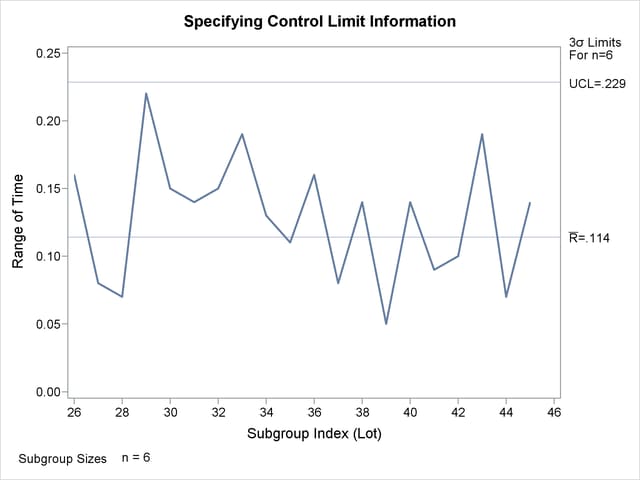RCHART Statement: SHEWHART Procedure
Note: See Specifying Control Limit Info for R Chart in the SAS/QC Sample Library.
This example illustrates how you can use a DATA step program to create a LIMITS= data set. You can provide previously established
values for the limits and central line with the variables _LCLR_, _R_, and _UCLR_, as in the following statements:
data Dlimits2; length _var_ _subgrp_ _type_ $8; _var_ = 'Time'; _subgrp_ = 'Lot'; _type_ = 'STANDARD'; _limitn_ = 6; _lclr_ = .03; _r_ = .12; _uclr_ = .25; run;
The following statements apply the control limits in Dlimits2 to the measurements in DISKS2 (see Reading Preestablished Control Limits) and create the R chart shown in Output 17.28.1:
ods graphics on; title 'Specifying Control Limit Information'; proc shewhart data=Disks2 limits=Dlimits2; rchart Time*Lot / odstitle=title; run;
In some cases, a standard value (![]() ) may be available for the process standard deviation. The following DATA step creates a data set named
) may be available for the process standard deviation. The following DATA step creates a data set named Dlimits3 that provides this value:
data Dlimits3; length _var_ _subgrp_ _type_ $8; _var_ = 'Time'; _subgrp_ = 'Lot'; _stddev_ = .045; _limitn_ = 6; _type_ = 'STDSIGMA'; run;
The variable _TYPE_ is a bookkeeping variable whose value indicates that the value of _STDDEV_ is a standard value rather than an estimate.
The following statements read the value of ![]() from
from Dlimits3 and create the R chart shown in Output 17.28.2:
title 'Specifying Control Limit Information'; proc shewhart data=Disks2 limits=Dlimits3; rchart Time*Lot / nolimit0 odstitle=title; run;
The NOLIMIT0 option suppresses the display of a fixed lower control limit if the value of the limit is zero (which is the case in this example).
Instead of specifying ![]() with the variable
with the variable _STDDEV_ in a LIMITS= data set, you can use the SIGMA0= option in the RCHART statement. The following statements create an R chart identical to the chart shown in Output 17.28.2:
proc shewhart data=Disks; rchart Time*Lot / sigma0=.045 nolimit0; run;
For more information, see LIMITS= Data Set.


